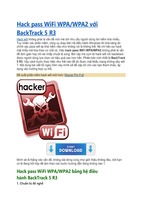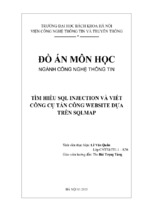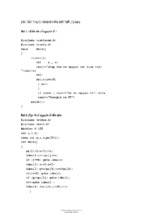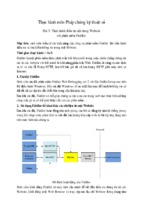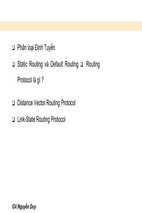398_FW_Policy_07.qxd
330
8/25/06
2:44 PM
Page 330
Chapter 7 • IT Infrastructure Security Plan
The level of these methods is determined by the system with the least capabilities.
Older operating systems cannot utilize the latest encryption technologies, for
example, so you might include policies that require that remotely connecting users
use the latest version of Windows XP Professional, to enable the entire end-to-end
communication link to use the strongest available encryption.You can also require
strong authentication across remote links. Different operating systems implement this
differently; in Windows Server 2003, for example, it’s implemented through policies
set in Administrative Tools | Routing and Remote Access.
Wireless Access
We’ve devoted a whole chapter to wireless security, so we will only discuss the toplevel items here:
■
Change access point default settings.
■
Disable SSID broadcasting; create a closed system (does not respond to
clients with “Any” SSID assigned).
■
Transmission power control (limiting the amount of power used for transmission to control the signal range).
■
Enable MAC address filtering.
■
Enable WEP or WPA.
■
Filter protocols.
■
Define IP allocations for the WLAN.
■
Use VPNs.
■
Secure users’computers.
All these choices have pros and cons, distinct advantages and disadvantages; you’ll
need to decide the right approach for your organization. As with all things in IT
security, it’s important that you understand the result of the solutions you’re using,
understand the configuration and maintenance of these elements, and be sure you
test them well in a lab or isolated setting before implementing them across the
enterprise.
Intrusion Detection Systems/
Intrusion Prevention Systems (IDS/IPS)
First, let’s define IDS and IPS, because they’re not one and the same. Intrusion detection systems (IDS) are passive in nature; they let you know an intrusion is taking place
398_FW_Policy_07.qxd
8/25/06
2:44 PM
Page 331
IT Infrastructure Security Plan • Chapter 7
or has occurred.They do nothing to stop an intrusion. On the other hand, an intrusion prevention system (IPS) is an active system that works to stop an intrusion or to
prevent one when “it thinks” one is occurring. How does “it” think? It does so
based on how you configure it, so we end up back at that persistent people problem
we’ve mentioned once or twice. An IPS has one major drawback, and that is the
high likelihood of false positives. Depending on how you configure the IPS, the
results of a response to a false positive might be far more devastating than an actual
intrusion, so you’re walking a fine line with IPS.That said, some excellent hardware
and software solutions are available on the market today, many of which are a great
improvement over IDS/IPS systems of the past. It is far outside the scope of this
book to discuss the pros and cons, the highlights and lowlights of these systems, so
we’re not going there. However, we will mention a few different ways you can
implement and secure your IDS/IPS systems and leave it up to you to develop a
specific plan for implementing these systems, since they are so varied.
A word of caution: IDS/IPS is not a standalone defense.You should implement it
with the understanding that it contributes to your depth of defense, but alone it will
not keep your network safe. It’s a great tool to have in your security toolkit, but it’s
not the magic bullet everyone wishes they had.
IPSs introduce fundamental performance and stability issues within the network
or system they are designed to protect.The act of implementing automatic controls
in response to detecting attacks does not come without a price. For example, an
inline network IPS will not forward packets before inspecting Application-layer data.
This inspection takes time and can result in a slowdown in the responsiveness and
throughput of the local network. A host IPS that has been charged with the inspection and validation of an application’s system calls can impact a kernel’s ability to
quickly service system calls, which may only be 1 to 15 percent but is probably
noticeable.
Network Active Response System
A network active response system has the ability to interact with network traffic indirectly through the modification of firewall policies and router Access Control Lists
(ACLs).They also have the ability to take down switch ports (for locally generated
attacks) and to spoof error code packets such as Transmission Control Protocol
(TCP), RST, or Internet Control Message Protocol (ICMP) unreachable packets.
Such an active response system is commonly implemented directly within a network
IDS, where it can easily take advantage of its detection capabilities.This is useful for
tearing down individual sessions or for trying to convince an attacking host that the
target is unreachable due to ICMP errors. However, there is not usually much time
331
398_FW_Policy_07.qxd
332
8/25/06
2:44 PM
Page 332
Chapter 7 • IT Infrastructure Security Plan
between these measures and the goal of the attack. It’s unclear whether the countermeasure will be successful.
There are four classes of countermeasure that a network IPS can utilize to
thwart a network-based attack. Each class applies to one layer of the protocol stack,
beginning at the Data Link layer:
■
Data Link layer countermeasures Administratively shut down a switch
port interface associated with a system from which attacks are being
launched.This approach is feasible only for attacks that are generated from a
local system. Having the ability to timeout the downed switch port is
important, since the port probably should not be shut down indefinitely.
■
Network layer countermeasures Interact with the external firewall or
router to add a general rule to block all communication from individual IP
addresses or entire networks. An inline IPS can accomplish the same thing
without having to appeal to an external device, since packets from specific
IP addresses can simply be blocked after an attack has been detected.
Similarly to Data Link layer responses, timeouts are important at the
Network layer, since the firewall rule set or router ACL modifications
should be removed after a configurable amount of time.
■
Transport layer countermeasures Generate TCP RST packets to tear
down malicious TCP sessions, or issues any of several available ICMP errorcode packets in response to malicious UDP traffic. (Note that ICMP is
strictly a Network layer protocol and is the standard method of communicating various errors to clients that utilize UDP).Timeouts are not applicable here, because countermeasures are leveraged against an attacker on a
per-session or per-packet basis.
■
Application layer countermeasures Alter malicious Application layer
data so as to render it harmless before it reaches the target system.This
countermeasure requires that the IPS be in line in the communication
path. Any previously calculated Transport layer checksum must be recalculated. Similarly to the Network layer, timeouts are not applicable here, since
the effects of replacing Application layer data are transitory and do not
linger once an altered packet is forwarded through the IPS.
Later in this chapter, we’ll walk through a number of “generic” countermeasures
and hardening tasks related to these layers when we look at various ways routers,
switches, and other network devices can be hardened in conjunction with whatever
IDS/IPS system you implement.
398_FW_Policy_07.qxd
8/25/06
2:44 PM
Page 333
IT Infrastructure Security Plan • Chapter 7
Host Active Response System
A host active response system is usually implemented in software and is deployed
directly on a host system. Once a suspicious event has been detected on a host
(through any number of means, such as log file analysis, detection of specific files or
registry keys associated with known exploits, or a suspicious server running on a
high port), a host active response system is charged with taking an action. As with
network active response, the expectation for a host active response system is that
countermeasures will not necessarily prevent an attack from initially being successful.
The emphasis is on trying to mitigate the effects and damage caused by an attack
after detection. After an attack is detected, automated responses can include alteration
of file system permissions, changes in access that a system grants to users, automated
removal of worms or viruses (anti-virus), and additions of new rules to a local firewall subsystem.
Before we move into system hardening, let’s take a look at how IDS/IPS systems
are implemented in the network infrastructure. Figure 7.2 shows the IDS system as
part of the infrastructure.The IDS server, in this case, would be connected to a span
port so that it would monitor all traffic on the local network.The IDS system is
capable of spoofing a TCP RST or ICMP error code packet to thwart the attack but
would not be effective against single-packet attacks.
Figure 7.2 IDS System Placement in Infrastructure
Network IDS
Attacker
Computer
Web sploit
to server ,
RST from IDS
RST to Web Server
and Attacker
Internet
Firewall
Switch
Web Server
Sploit from attacker,
RST from IDS
User Computer
User Computer
An inline system performs a bit differently, as shown in Figure 7.3. In this case,
the inline system captures the sploit and modifies it to protect the local network. A
333
398_FW_Policy_07.qxd
334
8/25/06
2:44 PM
Page 334
Chapter 7 • IT Infrastructure Security Plan
typical deployment of the IPS occurs just inside the firewall. In this position, it captures all incoming traffic before it goes to the local network, providing ubiquitous
protection, even for single-packet attacks. Because all traffic flows through an inline
IPS, downsides such as false positives and slower response times must be factored in.
Figure 7.3 IPS System Inline Placement in Infrastructure
Attacker
Computer
Raw sploit
Raw sploit
Modified sploit
Internet
Switch
Firewall
Web Server
Inline IPS
User Computer
User Computer
Next Generation Security Devices
As you look at your current implementation of IDS or IPS (or if you’re considering
an implementation), you should also keep an eye on recent developments in the
world of security devices. Network processors can be deployed in various architectures
including parallel, where each processor handles 1/N of the total load or pipeline,
where, as a packet moves through the pipeline, each processor typically handles a
single specific repetitive task.The network processor was originally targeted to the
routing market, but it is easy to see how it can be applied to the increased demands
of packet inspection in network security. For example, one processor could handle
the pattern matching for known worm signatures, another could analyze for protocol standards compliance, and yet another could look for protocol or usage
anomalies.The network processor would have direct access to fast memory that
stores policies and signatures, whereas slower, larger memory would store state information and heuristics information. New attacks could be mitigated by adding new
code to the network processor. A separate processor can handle management func-
398_FW_Policy_07.qxd
8/25/06
2:44 PM
Page 335
IT Infrastructure Security Plan • Chapter 7
tions such as logging and policy management. Network processors also offer the
ability to scale, much like CPUs on computer systems.
Business Intelligence…
Intrusion Prevention and Detection Resource
At the risk of sounding a bit self-serving, if you have any desire to understand
more about IDS/IPS, you really should check out another Syngress book. There
may be other excellent IDS/IPS resources out there, but Intrusion Detection and
Active Response: Deploying Network and Host IPS, by Michael Rash, Angela
Orebaugh, Graham Clark, Becky Pinkard, and Jake Babbin, with a foreword by
Stephen Northcutt (Syngress Publishing, Inc., 2005), is a great resource. If you’re
like most IT professionals, you’re inundated with technical information on a daily
(okay, hourly) basis and it’s hard to stay up to date on every topic in the computer world. This book provides excellent background information and helps you
understand the wild world of IDS/IPS so you can make informed decisions about
how, when, and where to implement it in your organization. If you’re looking for
an excellent resource on this topic, do yourself a favor and check out this onestop-shopping trip for an excellent IDS/IPS education.
System Hardening
Server security:
1. Always control physical and network access to critical servers, especially
domain controllers, DNS servers, DHCP servers, and other infrastructure
servers. Keep infrastructure servers in an access-controlled location.
2. Always perform tasks on the servers with the least possible privileges. Do
not perform tasks with Administrator privileges, if possible. Use the Run As
command (or equivalent) when needed.
3. Restrict user and machine access to groups that have loose security settings.
Provide users and computers with the least possible permissions while still
meeting their needs to access and use network resources.
4. Secure the data on the computers using strong ACLs and, if needed, the
syskey utility.The syskey utility provides protection against passwordcracking software that targets the Security Access Management (SAM)
335
398_FW_Policy_07.qxd
336
8/25/06
2:44 PM
Page 336
Chapter 7 • IT Infrastructure Security Plan
database or directory services. It uses strong encryption that is much more
difficult (if not close to impossible) and time consuming to crack.
5. Require the use of strong passwords via password policy settings.
6. Restrict the downloading and installation of programs that do not come
from known, trusted sources.
7. Maintain up-to-date virus protection on all systems.
8. Keep all software patches up to date. Patches often address newly discovered
security holes. Applying patches in a timely manner on all affected
machines can prevent problems that are easily avoided.
9. Deploy server, application and client-side security technologies:
■
Secure server traffic traveling on the network.
■
Secure application and user data traveling on the network.
■
Secure network access points and network access.
■
Secure client devices including desktops, laptops, and PDAs.
■
Implement automatically updating virus and spyware protection
systems.
Other Infrastructure Issues
1. Deploy network monitoring and auditing.
2. Develop a disaster recovery plan that includes creating backups, documenting recovery options and using repair and recovery tools.
3. Develop standard operating procedures that include strong monitoring,
auditing, and documentation.
Business Intelligence…
Rootkits
There’s been a lot of news in the recent past about the problems presented by
rootkit attacks. As you’re well aware, those little pieces of malware reside so deep
in the system that you can’t possibly remove them without completely starting
398_FW_Policy_07.qxd
8/25/06
2:44 PM
Page 337
IT Infrastructure Security Plan • Chapter 7
from scratch. After a system is compromised, all the affected software must be
reinstalled from known “clean” sources. Since it can be difficult to determine precisely which pieces of software have been affected, the best way to guarantee
security is to reinstall the entire operating system (OS) and all applications. OS
kernels can also be compromised (see www.rootkit.com), and when they are,
nothing on the system (even the most basic file system, memory, and network
status information) can be trusted. An after-the-fact forensic analysis of the file
system may turn up useful information if the disk is mounted underneath an
uncompromised OS, but this is a time-consuming operation.
Other Network Components:
Routers, Switches, RAS, NMS, IDS
There are numerous components that should be checked during an infrastructure
security project.The list in this section was compiled, in part, from a network checklist developed by the Defense Information Systems Agency (DISA) for the
Department of Defense (DoD). Although not all items listed will apply to your network and it’s possible that not all items that apply to your network appear on this
list, this is an extensive list that you can use as the starting point for your own
checklist. Some of the items in this list contain brief explanations included to help
you understand their importance. Our assumption is that you’re familiar with the ins
and outs of network security, but there are a few places where a quick clarification
will help, and we’ve included them as well.These are written in language that
reflects problems you would find that should be remedied (for instance, highlighting
the problem you’re looking for, not necessarily the solution you should implement).
The list is organized by device type, beginning with routers and other network
devices and moving on to firewalls, VLANs, RAS servers, and so on.
Network
■
Network infrastructure is not properly documented You should
begin with a clear understanding of how your network infrastructure is
currently configured.This should be well documented and kept up to date.
■
Network connections exist without approval All network connections should exist only with explicit approval or knowledge of the IT
department.This is typically a problem with modems, wireless access points,
and USB-type network devices.
337
398_FW_Policy_07.qxd
338
8/25/06
2:44 PM
Page 338
Chapter 7 • IT Infrastructure Security Plan
■
Unmanaged backdoor connections, backdoor network connections
bypass perimeter Every network in the world has a variety of backdoor
connections that network administrators use (or that software developers
build in). When unmanaged, these connections create security problems for
your network infrastructure.These are especially problematic when these
backdoors bypass perimeter security systems. If you can use them, so can
the bad guys.
■
Circuit location is not secure The location of network circuitry,
including the backbone and other highly critical components, should be
secured physically.
■
Network devices are not stored in secure communications room
This is part of physical security; to the extent possible, network devices
should be stored in a secure communications room.This should certainly
be true for mission-critical devices. Physical security of the company’s
premises, coupled with physical security of key network devices, is part of a
depth-in-defense strategy.
■
Minimum operating system release level All network devices—from
desktop computers to servers to firewalls to routers—should have the latest
updates and patches for the operating system they are running. As seen
from the top-20 threat list, many are threats to portions of the operating
system, so all device operating systems should be kept up to date. Where
possible, you may also choose to upgrade the operating system itself to a
newer, more secure version, where appropriate.This OS release-level maintenance should also apply to routers and other devices that have operating
systems, firmware, or other embedded software functionality.
■
DNS servers must be defined for client resolver If a router or similar
network device is specified as a client resolver (resolves DNS to IP address),
the router should have a DNS server defined. If the DNS server is specified, it makes it more difficult for an attacker to substitute his or her IP
address for that of the destination host. If this type of man-in-the-middle
attack is successful, the unsuspecting host user could transmit sensitive
information, including logon, authentication, and password data, to the
attacker.
398_FW_Policy_07.qxd
8/25/06
2:44 PM
Page 339
IT Infrastructure Security Plan • Chapter 7
External Communications (also see “Remote Access”)
■
Modems are not disconnected The problem with unsecured modems is
that they can be attacked by wardialers who simply look for modems connected to corporate networks.These can create significant security holes
and are often overlooked in our quest to lock down the wired network.
■
An ISP connection exists without written approval In most companies, this might be a difficult trick to achieve, but it certainly warrants
examination to ensure that the ISP connection(s) is managed by the IT
department and not some errant user who managed to get the local ISP
provider to run a cable into the office on a Saturday morning.
■
Communications devices are not password protected This seems
like a giant “Duh!” but you’d probably be surprised how often communication devices such as modems, routers, switches, and other “smart” devices
are left unprotected by even a simple password or that use the default password that came with the device out of the box.
■
No warning banner Failure to display the required login banner prior to
logon attempts will limit the site’s ability to prosecute unauthorized access.
It also presents the potential for criminal and civil liability for systems
administrators and information systems managers. Not displaying the proper
banner will also hamper the site’s ability to monitor device usage.
Displaying a banner warning users of the consequences of unauthorized
access helps warn off the bad guys and draws a line in the legal sand that
you might need later.
TCP/IP (Some TCP/IP
Information Also Found in the “Routers” Section)
■
LAN addresses are not protected from the public In later versions
of the Windows operating system, even home users were able to easily
implement Network Address Translation (NAT) to protect internal IP
addresses from Internet users. Most businesses these days have implemented
some method of protecting internal IP addresses so that hackers can’t use
this information to decipher the network structure and plan an attack.
339
398_FW_Policy_07.qxd
340
8/25/06
2:44 PM
Page 340
Chapter 7 • IT Infrastructure Security Plan
■
The DHCP server is not configured to log hostnames To identify
and combat IP address spoofing, it is highly recommended that the DHCP
server log MAC addresses or hostnames on the DHCP server.
■
TCP and UDP small server services are not disabled TCP and
UDP services are often available on network devices, including routers and
servers. Disabling these services if they’re not used helps reduce the attack
footprint.TCP and UDP protocols include services that routers can support; however, they are not required for operation. Attackers have used
these services to cause network DoS attacks.
■
TCP keepalives for Telnet session must be enabled Enabling TCP
keepalives on incoming connections can help guard against both malicious
attacks and orphaned sessions caused by remote system crashes. Enabling
the TCP keepalives causes the router to generate periodic keepalive messages, letting it detect and drop broken Telnet connections.
■
Identification support is enabled Identification support allows you to
query a TCP port for identification.This feature enables an unsecured protocol to report the identity of a client initiating a TCP connection and a
host responding to the connection. With identification support, you can
connect a TCP port on a host, issue a simple text string to request information, and receive a simple text-string reply.This is another mechanism to
learn the router vendor, model number, and software version being run.
Identification support should be disabled on routers and other network
devices that provide this functionality.
Business Intelligence…
Whitelisting
Whitelisting is the ability to easily specify IP addresses or networks that should
never be the subject of an automated response in an IDS/IPS system. For example,
IP addresses associated with systems that are critical to a network (for example,
the Domain Name Server, or DNS, or upstream router) should not be automatically blocked by an active response system, nor should sessions be altered by an
inline IPS. Some active response systems include the ability to whitelist IP
addresses and networks and to specify which protocols should be ignored. For
example, if a DNS server sends an attack across the network to a Web server, it
may be permissible for an active response system to capture the individual TCP
session on port 80 but ignore everything else.
398_FW_Policy_07.qxd
8/25/06
2:44 PM
Page 341
IT Infrastructure Security Plan • Chapter 7
■
IP-directed broadcasts are not disabled An IP-directed broadcast is a
datagram sent to the broadcast address of a subnet that is not directly
attached to the sending machine.The directed broadcast is routed through
the network as a Unicast packet until it arrives at the target subnet, where
it is converted into a link layer broadcast. Due to the nature of the IP
addressing architecture, only the last router in the chain, which is connected
directly to the target subnet, can conclusively identify a directed broadcast.
IP-directed broadcasts are used in the extremely common and popular
smurf, or DoS, attacks. In a smurf attack, the attacker sends ICMP echo
requests from a falsified source address to a directed broadcast address,
causing all the hosts on the target subnet to send replies to the falsified
source. By sending a continuous stream of such requests, the attacker can
create a much larger stream of replies, which can completely inundate the
host whose address is being falsified.This service should be disabled on all
interfaces when it’s not needed to prevent smurf and DoS attacks.
■
Ingress filtering inbound spoofing addresses Inbound spoofing occurs
when someone outside the network uses an internal IP address to gain
access to systems or devices on the internal network. If the intruder is successful, they can intercept data, passwords, and the like and use that information to perform destructive acts on network devices or network data.
■
Egress outbound spoofing filter You should restrict the router from
accepting any outbound IP packet that contains an illegitimate address in
the source address field via egress ACLs or by enabling Unicast Reverse
Path Forwarding. ACLs are the first line of defense in a layered security
approach.They permit authorized packets and deny unauthorized packets
based on port or service type.They enhance the network’s posture by not
allowing packets to even reach a potential target within the security
domain. Auditing packets attempting to penetrate the network but that are
stopped by an ACL will allow network administrators to broaden their protective ring and more tightly define the scope of operation.
Administration
■
Devices exist that have standard default passwords This is another
major “Duh!” item; again, it’s surprising how easy it is to get into a large
number of devices just by using the default password that the device
shipped with. Want to know the default password? Go up on the manufacturer’s Web site, look for the user guide for the specific device, and the
341
398_FW_Policy_07.qxd
342
8/25/06
2:44 PM
Page 342
Chapter 7 • IT Infrastructure Security Plan
default password is almost guaranteed to be listed in the first five pages of
the manual.
■
Group accounts or user accounts without passwords Without passwords on user accounts for network devices, one level of complexity is
removed from gaining access to the routers. If a default user ID has not
been changed or is guessed by an attacker, the network could be easily
compromised, since the only remaining step would be to crack the password. Sharing group accounts on any network device should also be prohibited. If these group accounts are not changed when someone leaves the
group, that person could possibly gain control of the device. Having group
accounts does not allow for proper auditing of who is accessing or
changing the network. Only allow individual user account access and
require each user to have a unique user ID and a strong password.
■
Assign lowest privilege level to user accounts Across the enterprise,
you should always assign the least privilege possible for all users.This prevents users from getting into places they shouldn’t, and it also prevents
hackers from upgrading their privileges if they manage to get in on a user
account that has too many privileges. Even IT staff should have user
accounts with least privileges for most day-to-day network tasks, and they
should only log on with administrative privileges when needed. Network
outages and security holes can be created by users with too many permissions or even by a well-meaning but inexperienced net admin.
■
Strong password policies are not enforced Strong passwords is an
inadequate defense on its own, but it slows down a would-be intruder and
can also alert a net admin to a potential problem if failed password attempts
are monitored and accounts are locked down after too many failed
attempts. Requiring users to use strong passwords, to change them periodically, and to prevent them from repeating old passwords too frequently are
all parts of strong password policy. In addition, you can audit failed
attempts, notify a net admin of too many failed attempts, and lock out an
account with too many failed accounts as part of your strong password
policy implementation.
■
Passwords are not recorded and stored properly User passwords
should not be recorded and stored, but certain administrative ones absolutely should be.You can probably think of several scenarios where
someone who doesn’t normally require administrative access requires it.
For example, suppose as part of your disaster recovery plan, you have an
398_FW_Policy_07.qxd
8/25/06
2:44 PM
Page 343
IT Infrastructure Security Plan • Chapter 7
executive VP who is responsible for coordinating recovery efforts. He or
she should have access to these passwords only for these emergency situations, because on a day-to-day basis, you operate on the principle of “least
access” and the EVP really has nothing more than the equivalent rights of
a power user. Having these passwords on a network server in plain sight
or in a paper file someplace obvious is not a good idea. Making sure these
emergency passwords are recorded and stored properly ensures security
for the network on a day-to-day basis but provides an important fail-safe
option in emergencies as well.
■
Passwords are viewable when displaying the router or other device
Many attacks on computer systems are launched from within the network
by unsatisfied or disgruntled employees. It’s vital that all router passwords be
encrypted so they cannot be intercepted by viewing the console. If the
router network is compromised, large parts of the network could be incapacitated with just a few simple commands.
■
Passwords are transmitted in clear text There are many types of situations in which passwords are transmitted in clear text.This creates an
opportunity for an attacker to seize passwords. Review how and where
passwords are transmitted and secure the communication lines if the passwords themselves are transmitted in clear text.
■
Emergency accounts should be limited to one Emergency accounts
on devices such as routers or switches should be limited to one.
Authentication for administrative access to the router should obviously be
required at all times. A single account can be created on the router’s local
database for use in an emergency, such as when the authentication server is
down or connectivity between the router and the authentication server is
not operable. Verify that there is one and only one emergency account to
prevent unnecessary opportunities for attack.
■
Unnecessary or unauthorized router or device accounts exist This
point is related to the previous item.You should eliminate any unused,
unnecessary, or unauthorized device accounts except for one authorized
emergency account.
■
Disable unused ports and services On every server, every firewall, and
every device, disable unused ports and services. Microsoft took a giant leap
forward in the more recent versions of the Windows operating system
when the company changed the default configuration from “open” to
“closed.”This meant that the net admin had to consciously enable and
343
398_FW_Policy_07.qxd
344
8/25/06
2:44 PM
Page 344
Chapter 7 • IT Infrastructure Security Plan
open services and ports after installation. Earlier versions came open and
unlocked out of the box, and the net admin had to sift through the system
to lock it down. For all devices, disable unused ports and services, uninstall
unused applications, and remove unused hardware.
■
Auditing and logging files are not set to record denied events, not
set to record system activity Auditing and logging are key components
of any security architecture. It is essential that security personnel know
what is being done, being attempted, and by whom in order to compile an
accurate risk assessment. Auditing the actions, particularly denied events, on
routers provides a means to identify potential attacks or threats. Maintaining
an audit trail of system activity logs (syslog) can help you identify configuration errors, understand past intrusions, troubleshoot service disruptions, and
react to probes and scans of the network.
■
Configurations are stored in unsecured locations To ensure network
and data availability, the configuration data of key network infrastructure
components should be maintained in a secure, offsite location.This is part
of good disaster recovery planning practices and adds to security if these
configurations are stored in secured locations offsite rather than in an
unlocked file cabinet in the mailroom. Access to these configuration files
should be restricted and logged to prevent unauthorized access.
Network Management
■
Out-of-band network management not implemented or required
It’s outside the scope of this chapter (and book) to get into a deep discussion of in-band and out-of-band network management, but we will toss
out a couple of quick explanations before discussing the infrastructure
security implications of both. In-band network management uses the same
network infrastructure as the devices and data being managed. Most networking equipment basically sends out IP traffic for network management
on the same medium as the traffic it’s managing (routers, switches, and so
forth). Out-of-band network management uses a separate connection, often
a serial RS-232 port, instead of the network port used for in-band management.There are security pros and cons to both, so the key is to secure
whichever method(s) you implement.
Without secure out-of-band management implemented with authenticated access controls, strong two-factor authentication, encryption of the
398_FW_Policy_07.qxd
8/25/06
2:44 PM
Page 345
IT Infrastructure Security Plan • Chapter 7
management session, and audit logs, unauthorized users may gain access to
network managed devices such as routers or communications servers (CS).
If the router network is compromised, large parts of the network could be
incapacitated with only a few commands. If a CS is compromised, unauthorized users could gain access to the network and its attached systems.
The CS could be disabled, therefore disallowing authorized subscribers
from supporting mission critical functions.
From an architectural point of view, providing out-of-band management of network systems is the best first step in any management strategy.
No network production traffic resides on an out-of-band network.
■
Use of in-band management is not limited, restricted, or
encrypted It is imperative that communications used for administrative
access to network components are limited to emergency situations or
where out-of-band management would hinder daily operational requirements. In-band management introduces the risk of an attacker gaining
access to the network internally or even externally. In-band management
should be restricted to a limited number of authorized IP addresses to
improve security.The in-band access should also be encrypted for added
security. Without encrypted in-band management connections, unauthorized users may gain access to network managed devices such as routers,
firewalls, or remote access servers. If any of these devices are compromised,
the entire network could also be compromised. Administrative access
requires the use of encryption on all communication channels between the
remote user and the system being accessed. It is imperative to protect communications used for administrative access because an attacker who manages to hijack the link would gain immediate access to the network.
■
Log all in-band management access attempts Since in-band traffic
travels on the same pathways as normal network traffic, be sure that all inbound management access attempts are logged.This will give you an indication as to whether an intruder is attempting to gain control of key
network devices.These attempts should not go unnoticed and should be
verified against legitimate management activity of that device. For example,
if the access attempts happen after business hours, it’s possible (or likely)
that the attempts are unauthorized.
■
Two-factor authentication is not used for in-band or out-of-band
network management Without strong two-factor authorization, unauthorized users may gain access to network managed devices such as routers,
345
398_FW_Policy_07.qxd
346
8/25/06
2:44 PM
Page 346
Chapter 7 • IT Infrastructure Security Plan
firewalls, and remote access servers. If any of these devices are compromised, the entire network could also be compromised.
■
Filter ICMP on external interface The Internet Control Message
Protocol (ICMP) supports IP traffic by relaying information about paths,
routes, and network conditions. ICMP unreachable notifications, mask
replies, and redirects should be disabled on all externally-interfaced routers
to prevent hackers using these messages to perform network mapping and
infrastructure discovery.
■
SNMP access is not restricted by IP address Detailed information
about the network is sent across the network via SNMP. If this information
is discovered by attackers, it could be used to trace the network, show the
network topology, and possibly gain access to network devices. Access to
SNMP should be for specific IP addresses only.
■
SNMP is blocked at all external interfaces Clearly, using SNMP to
map a network and discover the network infrastructure is a great hacker
tool that should be secured to the greatest extent possible.This includes
blocking SNMP on all external interfaces.
■
SNMP write access to the router is enabled This allows an intruder
to set various configuration settings to allow him or her greater access to
the router and hence to the network. SNMP write access should be disabled.
■
Block identified inbound ICMP messages Using inbound ICMP
Echo, Information, Net Mask, and Timestamp requests, an attacker can
create a map of the subnets and hosts behind the router. An attacker can
perform a DoS attack by flooding the router or internal hosts with Echo
packets. With inbound ICMP Redirect packets, the attacker can change a
host’s routing tables.
■
Block identified outbound ICMP traffic An attacker from the internal
network (behind the router) may be able to launch DoS attacks with outbound ICMP packets. It is important to block all unnecessary ICMP traffic
message types.
■
Block all inbound traceroutes If you’re ever had to troubleshoot a network or Internet connection, you’re familiar with the traceroute command.
This is a helpful tool in troubleshooting, but it also provides great information to a would-be attacker to create a map of the subnets and hosts behind
398_FW_Policy_07.qxd
8/25/06
2:44 PM
Page 347
IT Infrastructure Security Plan • Chapter 7
the router.These should not be allowed into the network through the
router or other externally facing devices.
■
Secure NMS traffic using IPSec To securely protect the network,
Network Management Systems (NMS) and access to them must be controlled to guard against outside or unauthorized intrusion, which could
result in system or network compromise. Allowing any device to send traps
or information may create a false positive and having site personnel perform unneeded or potentially hazardous actions on the network in
response to these false traps.These sessions must be controlled and secured
by IPSec.
■
An insecure version of SNMP is being used SNMP Versions 1 and 2
are not considered secure and are not recommended. Instead, use SNMP
Version 3, which provides the User-based Security Model (USM), which
gives strong authentication and privacy. Without Version 3, it’s possible an
attacker could gain unauthorized access to detailed network management
information that can be used to map and subsequently attack the network.
■
SNMP standard operating procedures are not documented
Standard operating procedures will ensure consistency and will help prevent
errors or omissions that could create a security hole.
■
NMS security alarms not defined by violation type or severity
Ensure that security alarms are set up within the managed network’s framework. At a minimum, these will include the following:
■
Integrity violation Indicates that network contents or objects have
been illegally modified, deleted, or added.
■
Operational violation Indicates that a desired object or service could
not be used.
■
Physical violation Indicates that a physical part of the network (such
as a cable) has been damaged or modified without authorization.
■
Security mechanism violation Indicates that the network’s security
system has been compromised or breached.
■
Time domain violation Indicates that an event has happened outside its allowed or typical time slot.
Also ensure that alarms are categorized by severity using the following
guidelines:
347
398_FW_Policy_07.qxd
348
8/25/06
2:44 PM
Page 348
Chapter 7 • IT Infrastructure Security Plan
■
Critical and major alarms are given when a condition that affects service has arisen. For a critical alarm, steps must be taken immediately to
restore the service that has been lost completely.
■
A major alarm indicates that steps must be taken as soon as possible
because the affected service has degraded drastically and is in danger of
being lost completely.
■
A minor alarm indicates a problem that does not yet affect service but
may do so if the problem is not corrected.
■
A warning alarm is used to signal a potential problem that may affect
service.
■
An indeterminate alarm is one that requires human intervention to
decide its severity.
Without the proper categories of security alarm being defined on the
NMS, responding to critical outages or attacks on the network may not be
coordinated correctly with the right personnel, hardware, software, or
vendor maintenance. Delays will inevitably occur that will cause network
outages to last longer than necessary or expose the network to larger, more
extensive attacks or outages.
■
The NMS is not located in a secure environment Any network
management server (or any other highly critical network component)
should be kept in a physically secure location with restricted access. Since
many attacks come from inside an organization, by people who are authorized to be on the premises, it’s important to physically secure all critical
network components to the greatest degree possible. Using keypad or cardswipe access control can also help identify specific administrative access, to
allow you to further control and monitor access.
Access to NMS and other network critical components should be
restricted via access controls as well ,and all activity, including all successful
and failed attempts to log on, should be logged.The log file, as with all log
files, should be reviewed regularly, stored for 30 days, and archived for a
year, unless regulatory or compliance requirements differ.
■
NMS accounts are not properly maintained Only those accounts
necessary for the operation of the system and for access logging should be
maintained.This is true for all servers and network devices. Good “housekeeping” is an essential element to network security, and removing or disabling unused accounts as well as removing and investigating
398_FW_Policy_07.qxd
8/25/06
2:44 PM
Page 349
IT Infrastructure Security Plan • Chapter 7
Routers and Routing
■
No documented procedures and maintenance for MD5 keys
Routing protocols should use MD5 to authenticate neighbors prior to
exchanging route table updates, to ensure that route tables are not corrupted or compromised.
■
MD5 Key Lifetime expiration is set to never expire MD5 is a public
key encryption algorithm that uses the exchange of encryption keys across
a network link. If these keys are not managed properly, they could be intercepted by unauthorized users and used to break the encryption algorithm.
This check is in place to ensure that keys do not expire, creating a DoS due
to adjacencies being dropped and routes being aged out.The recommendation is to use two rotating six-month keys, with a third key set as infinite
lifetime.The lifetime key should be changed seven days after the rotating
keys have expired.
■
Console port is not configured to time out Console ports on routers
or other network devices should be set to time out after some specified
period of inactivity. In most cases, a 5- or 10-minute timeout is appropriate. A router is a highly desirable asset to an intruder, so setting a low
threshold on timeout will help increase security.
■
Modems are connected to the console or aux port There may be
valid reasons to have a modem connected to the console or auxiliary port
of a router or other network device, but you should first ensure that this
connection is absolutely necessary. If not, remove it. If it is needed, be sure
to secure it by requiring a username and password (and other security measures) and avoid default configurations.
■
The router or network device’s auxiliary port is not disabled If
the router or other network device has an auxiliary port, be sure it is disabled it if it’s not in use.These are the kinds of welcome backdoors
hackers look for.
■
Login is not limited to three attempts Login attempts for any network device that exceed three tries are likely the work of a hacker.
Limiting login attempts to three is a reasonable limit, and most net admins
will stop after three attempts if they cannot recall the appropriate login.
This won’t stop a hacker who is willing to try three times, wait some specified interval, and try again, but it will prevent automated attacks from going
through quickly (or at all).
349
- Xem thêm -





